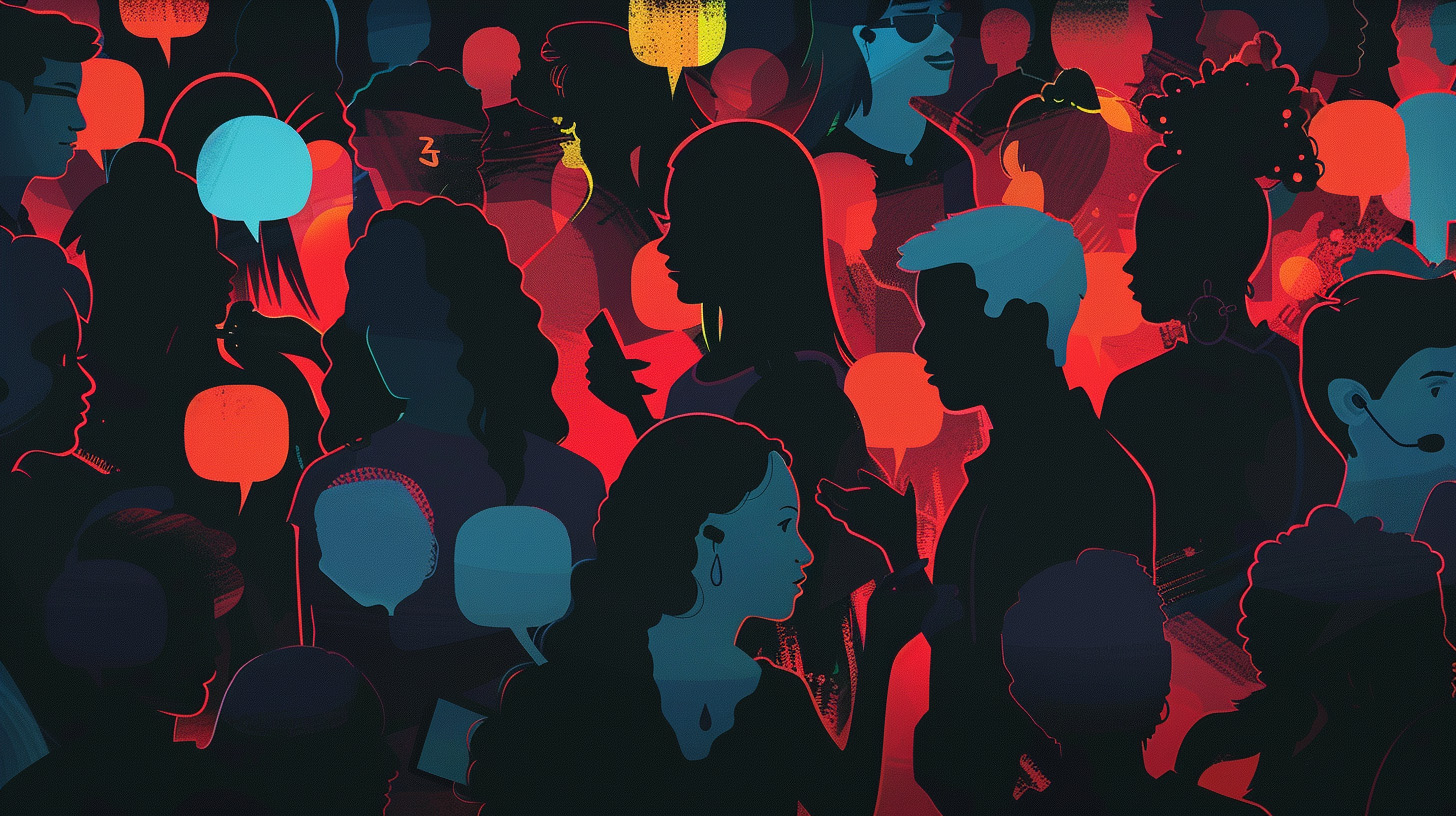With the rise of AI, the digital landscape is changing fast—but that’s not always a good thing.
Gone are the days when we could just post a few updates on Facebook and call it a day. With the rise of misinformation and declining trust in social media (in no small part due to AI content), consumers are getting savvier – and more skeptical – by the minute.
But here’s the good news: there’s a new frontier in social media that smart brands are starting to explore. It’s called “dark social,” and it’s all about building authentic relationships with your customers in private channels like messaging apps and invite-only groups.
Here’s how it works.
Market on social, sell off. Ensure your gateway can handle it.

What is Dark Social?
Despite its ominous name, dark social simply refers to all the ways people share content privately online – think messaging apps, email, private groups, and the like. Basically, any sharing that happens outside of the public eye (and traditional tracking methods).
Dark social vs. the social media giants
So how does dark social differ from the Facebooks and Instagrams of the world? It all comes down to visibility. With public social media, brands can easily see how their content is being shared and engaged with. But with dark social, that sharing is happening behind closed doors, making it harder to track and attribute.
Why consumers are flocking to the dark side
Now, you might be wondering – why the sudden surge in dark social? Well, it turns out there are a few key reasons:
- Distrust in social media: With data privacy scandals and misinformation running rampant, many people are losing faith in public social networks. They’re craving more intimate, trustworthy spaces to connect.
- Privacy concerns: Consumers are getting savvier about protecting their personal data. They don’t want every like, comment, and share to be tracked and analyzed by brands. Dark social offers a refuge from prying eyes.
- Desire for authentic connections: In a world of curated feeds and sponsored posts, people are hungry for real, genuine interactions. Private messaging and invite-only communities provide a space for more authentic, meaningful conversations.

The Opportunity for Businesses
Dark social isn’t just a trend to watch – it’s a massive opportunity for businesses to build trust and authentic relationships with their customers.
In a world where people are increasingly skeptical of brands, dark social provides a space for genuine, human connection. By engaging with your audience in private channels, you can show them that you’re not just another faceless corporation, but a group of real people who care about their needs and interests.
Turning customers into brand ambassadors
One of the biggest benefits of dark social is its potential for word-of-mouth marketing. When people share your content with their friends and family in private messages, it carries way more weight than a public post. It’s like a personal recommendation from someone they trust.
By encouraging your customers to share your content in dark social channels, you can tap into this powerful referral network. Create content that’s valuable, entertaining, and shareable – and make it easy for people to spread the word with share buttons and referral links.
Meeting your audience where they hang out
Another key advantage of dark social is that it allows you to reach your audience where they’re already spending their time. Instead of trying to drag them to your landing page or social media profile, you can meet them on their favorite messaging apps and private communities.
By being present in these spaces, you can create a more seamless, integrated experience for your customers. You can answer their questions, provide support, and build relationships in a way that feels natural and unobtrusive.
Boost Your Bottom Line with Powerful Payment Processing
Strategies for Leveraging Dark Social
If you want your audience to share your content in dark social channels, you’ve got to make it as easy as possible. One simple way to do this is by adding “share this” buttons for popular messaging apps like WhatsApp, Facebook Messenger, and Telegram.
When someone clicks on these buttons, it should automatically generate a pre-written message with a link to your content that they can easily send to their friends. The fewer steps involved, the more likely people are to share.
Experiment with click-to-message ads
You know those ads on Facebook and Instagram that allow you to start a conversation with a brand directly in Messenger? Those are click-to-message ads, and they’re a powerful way to engage with your audience in dark social channels.
By creating ads that encourage people to chat with you privately, you can build more personal relationships and provide a higher level of customer service. Plus, you can use chatbots to automate parts of the conversation and make the experience more efficient (depending on what the customer is asking for—don’t go to heavy on the AI).
Create exclusive communities
Another way to leverage dark social is by creating private groups and communities for your most engaged customers. This could be a Facebook Group, a Slack community, a server on Discord, or even a group chat on a messaging app.
By providing a space for your customers to connect with each other and with your brand, you can foster a sense of belonging and loyalty. You can also use these communities to gather feedback, share exclusive content, and offer special perks and promotions.
Partner with influencers
Influencer marketing isn’t just for public social media – it can be a powerful tool for dark social as well. By partnering with influencers who have engaged followings on messaging apps and private communities, you can tap into new audiences and build credibility.
Look for influencers who align with your brand values and have a strong presence in the dark social media channels your target audience uses. Then, work with them to create content that feels authentic and valuable to their followers.
The key to success with dark social is to be genuine, helpful, and human. Don’t just blast out promotional messages – take the time to build real relationships and provide value to your audience. With the right strategies and a little creativity, you can unlock the power of dark social and take your digital marketing to the next level.

Measuring the Impact of Dark Social
Traditional web analytics (like Google Analytics) and referral data just don’t cut it when it comes to private sharing tracking information.
When someone shares your content via a messaging app or email, it often shows up as “direct traffic” in your analytics dashboard. That means you can’t see where the traffic is coming from or how people are engaging with your content.
UTM parameters to the rescue
But fear not! There are ways to track dark social activity. One of the most effective tools is UTM parameters.
By adding these special tracking codes to your URLs, you can see how people are sharing your content, even in private channels. When someone clicks on a link with a UTM parameter, it sends data back to your analytics tools, allowing you to see the source, medium, and campaign associated with that link.
Diving into direct traffic
Another way to measure dark social is by looking at direct traffic to key webpages on your site. If you see a sudden spike in direct web traffic to a specific blog post or product page, it could be a sign of dark social sharing.
To get a better sense of where this traffic is coming from (and whether it’s dark social traffic), you can use advanced tracking tools like ShareThis or GetSocial. These platforms provide more detailed insights into private sharing activity and can help you identify which pieces of content are resonating with your audience.
Connecting the dots
Finally, it’s important to remember that dark social doesn’t exist in a vacuum. To truly understand its impact, you need to look at how it correlates with other metrics like sales, sign-ups, and customer engagement.
For example, if you launch a dark social campaign promoting a new product, keep an eye on your sales data in the following days and weeks. If you see a significant increase in purchases, it’s a good sign that your campaign is working.
Measuring the impact of dark social may require a bit of creativity and experimentation, but it’s well worth the effort.
Meet your customers where there are. Improve your checkout experience.
Popular Platforms and Apps for Dark Social
Messaging apps
When it comes to dark social, messaging apps are where the magic happens. These private, one-on-one or group conversations are the perfect place for people to share content and talk about brands they love. Some of the most popular messaging apps for dark social include:
- Facebook Messenger
- Telegram
- Snapchat
- Viber
- Kik
Private groups
Another hotspot for dark social activity is private groups and communities. These invite-only spaces allow people to connect with like-minded individuals and share content in a more intimate setting. Some of the most popular platforms for private groups include:
- Facebook Groups
- LinkedIn Groups
- Slack communities
- Discord servers
- Reddit (private subreddits)
- Mighty Networks
- Telegram channels
Other platforms
But dark social doesn’t just happen on dedicated social media apps. There are plenty of other platforms where people are sharing content and engaging in private conversations. Some examples include:
- Zoom (private meetings and chats)
- SMS/text messaging
- Podcasts (mentions and recommendations)
- Skype
- Google Meet
- FaceTime
The key thing to remember is that dark social can happen anywhere people are having private conversations online. As a marketer, your job is to create content that’s so valuable and engaging, people can’t help but share it with their friends and colleagues – no matter what platform they’re using.

Should Businesses Still Use Public Social Media?
Now, you might be thinking – with all this talk about dark social, should businesses even bother with public social media anymore? The answer is a resounding yes, but with a caveat.
Public social content should be just one part of a larger, multi-channel social strategy that includes both public and private channels. By using them together, you can create a more comprehensive and effective marketing approach.
The perks of going public
Despite the rise of dark social, public social media still has a lot to offer businesses. Some of the key benefits include:
- Reach: Public social media platforms have massive user bases, allowing you to reach a wide audience with your content.
- Brand awareness: By maintaining a strong presence on public social media, you can increase your brand’s visibility and build recognition with your target audience.
- SEO: Social media signals can impact your search engine rankings, making it easier for people to find your brand online.
The power of integration
But the real magic happens when you integrate your public and private social media efforts. By using public channels to drive traffic and engagement to your private communities, you can create a virtuous cycle of growth and loyalty.
For example, you might use Instagram to tease exclusive content that’s only available in your private Facebook Group. Or you could use LinkedIn to promote a webinar that includes a private Q&A session on Zoom.
By using public and private channels together, you can create a more seamless and engaging experience for your audience, while still reaping the benefits of both worlds.
The bottom line
At the end of the day, the key is to find the right balance between public and private social media for your brand. There’s no one-size-fits-all approach – it all depends on your audience, your goals, and your resources.
But by incorporating dark social into your larger social media strategy, you can create a more holistic and effective approach that drives real results for your business. So don’t be afraid to experiment, iterate, and find what works best for you!
SCALE YOUR BUSINESS WITH DIRECTPAYNET
Dark Social FAQ
How do I get started with dark social marketing?
Getting started with dark social media marketing can seem daunting, but it doesn’t have to be. Here are a few simple steps to get you going:
- Identify your audience: Figure out where your target customers are already having private conversations online.
- Create shareable content: Develop content that’s valuable, entertaining, and easy to share in private channels.
- Encourage sharing: Add “share this” buttons to your content and encourage your audience to spread the word.
- Engage in private channels: Join relevant private groups and communities, and start building relationships with your audience.
What kind of content works best for dark social?
The best content for dark social is anything that’s highly relevant, valuable, and shareable for your target audience. Some examples might include:
- Exclusive offers and promotions
- Behind-the-scenes content and sneak peeks
- Personalized recommendations and advice
- Entertaining or humorous content
- Thought leadership and industry insights
The key is to create content that people will want to share with their friends and colleagues in private conversations.
How much should I invest in dark social vs other channels?
The amount you invest in dark social will depend on your overall marketing strategy and goals. As a general rule, it’s a good idea to allocate a portion of your budget to experimenting with dark social and see how it performs.
Over time, you can adjust your investment based on the results you’re seeing and the ROI of your dark social efforts compared to other channels.
What are some examples of dark social marketing campaigns?
There are plenty of examples of brands that have successfully leveraged dark social to drive engagement and sales. Here are a few notable ones:
- Glossier: The beauty brand uses dark social to create a sense of exclusivity and community around its products, with private Slack groups and referral programs.
- Burger King: The fast-food chain has used dark social to launch secret menu items and promotions, encouraging customers to share them with friends in private instant messages.
- Adidas: The sportswear brand has partnered with influencers to create exclusive content for private messaging apps, driving buzz and sales for new product launches.
The key takeaway from these examples is that dark social can be a powerful tool for building loyalty, driving engagement, and creating a sense of exclusivity around your brand.
